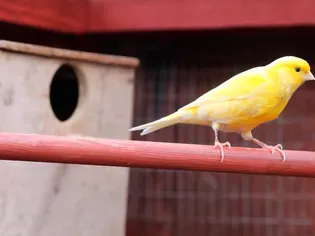How to Hold a Bird Safely
Updated on 05/26/24

Mastering the Art of Avian Handling: A Comprehensive Guide to Holding a Bird Safely
In the enchanting world of birdkeeping, fostering a harmonious bond with our feathered companions requires a deep understanding of their delicate nature. Among the essential skills every avian enthusiast should possess is the ability to handle their birds safely and confidently. This comprehensive guide will delve into the intricacies of bird handling, providing invaluable insights and practical techniques to ensure the well-being of your beloved bird.
1. Foundations of Bird Handling: Understanding Body Language and Temperament
Before attempting to hold a bird, it's crucial to establish a strong foundation of trust and understanding. Birds communicate through subtle body language cues, and learning to interpret these signs will enable you to approach your bird with confidence and minimize stress.
* Relaxed Body Posture: A bird that is comfortable and relaxed will typically have a loose and relaxed body posture. Its feathers will be smooth and sleek, and its head will be held high.
* Dilated Pupils: When a bird is frightened or stressed, its pupils will dilate. Conversely, relaxed birds will have constricted pupils.
* Tail Position: A bird's tail can reveal its mood. A bird with a slightly raised tail is usually alert and relaxed, while a bird with a tightly tucked tail is likely feeling scared or threatened.
* Wing Position: Relaxed birds will have their wings slightly drooped. Birds with raised wings may be preparing to fly or defend themselves.
2. Gentle Approach and Secure Hold: Techniques for Safe Handling
Once you have established a rapport with your bird, it's time to approach it cautiously and secure a safe hold. Remember to always move slowly and avoid sudden movements that could startle your bird.
* Step 1: Engage the Bird with Soft Words and Treats: Before attempting to handle your bird, engage it with gentle words and tempting treats. This will help create a positive association and reduce anxiety.
* Step 2: Scoop and Cradle the Bird Gently: Using your dominant hand, gently scoop the bird's body from underneath and cradle it securely in your hand, supporting its chest and legs. Avoid gripping the bird too tightly, as this could cause discomfort.
* Step 3: Secure the Bird's Head and Tail: With your other hand, gently secure the bird's head and tail to prevent it from struggling. Do not apply excessive pressure, as this could injure the bird.
3. Handling Specific Bird Species: Tailored Techniques for Different Birds
Different bird species have unique characteristics that require tailored handling techniques. Understanding these variations will ensure the safety and comfort of your feathered friend.
* Parrots and Cockatiels: These birds have strong beaks and can deliver a powerful bite. When handling parrots and cockatiels, it's important to be firm but gentle, and avoid holding them by the tail.
* Canaries and Finches: These small birds are delicate and require a light touch. Handle canaries and finches with care, avoiding excessive pressure on their bodies.
* Raptors (Birds of Prey): Raptors have sharp talons and beaks, so handling them requires specialized knowledge and equipment. Always wear protective gear and seek guidance from an experienced falconer before attempting to handle a raptor.
4. Emergency Situations: Responding to Bites, Struggles, and Falls
In the unlikely event of an emergency, it's crucial to stay calm and respond swiftly and effectively.
* Bites: If a bird bites you, remain calm and avoid pulling your hand away abruptly. Gently disengage the bird's beak by applying pressure to the base of its beak and firmly saying "no."
* Struggles: If a bird struggles in your hand, do not tighten your grip. Instead, gently but firmly restrain the bird until it calms down. Avoid squeezing or suffocating the bird.
* Falls: If a bird falls, immediately assess its condition. Check for any injuries and provide immediate care if necessary. Contact your avian veterinarian for further assistance.
5. Beyond Safety: Enhancing the Bond with Your Bird
Beyond the safety aspect, proper handling techniques can deepen the bond between you and your bird. By handling your bird regularly in a calm and gentle manner, you will gradually build trust and establish a strong connection.
* Positive Reinforcement: Reward your bird with treats or praise for good behavior during handling. This will reinforce desired behaviors and strengthen the bond between you.
* Regular Examinations: Frequent handling provides an opportunity to examine your bird's body condition, plumage, and overall health. Early detection of any abnormalities can lead to prompt veterinary care and improved outcomes.
* Enhanced Communication: Through consistent and gentle handling, you will become attuned to your bird's body language and vocalizations. This enhanced communication will foster a deeper understanding and empathy between you and your feathered friend.
Conclusion: The Joy of Safe Bird Handling
Mastering the art of bird handling is a rewarding skill that not only ensures the safety and well-being of your bird but also strengthens the bond between you. By understanding your bird's body language, approaching it gently, and using tailored techniques for different species, you can create a trusting and harmonious relationship that will enrich your life for years to come. Embrace the joy of safe bird handling and embark on an extraordinary journey of avian companionship and care.
Explore More Pets

Small Bird Breeds
Gloster Canary: Bird Species Profile

Small Bird Breeds
Java Finch: Bird Species Profile

Small Bird Breeds
Zebra Finch (Chestnut-Eared Finch): Bird Species Profile

Small Bird Breeds
Alexandrine Parakeet: Species Characteristics & Care

Small Bird Breeds
Canary: Bird Species Profile

Small Bird Breeds
Lovebird (Pocket Parrot) Species Profile

Small Bird Breeds
A Guide to Pet Budgie Birds

Small Bird Breeds
Types of Small Parrots
